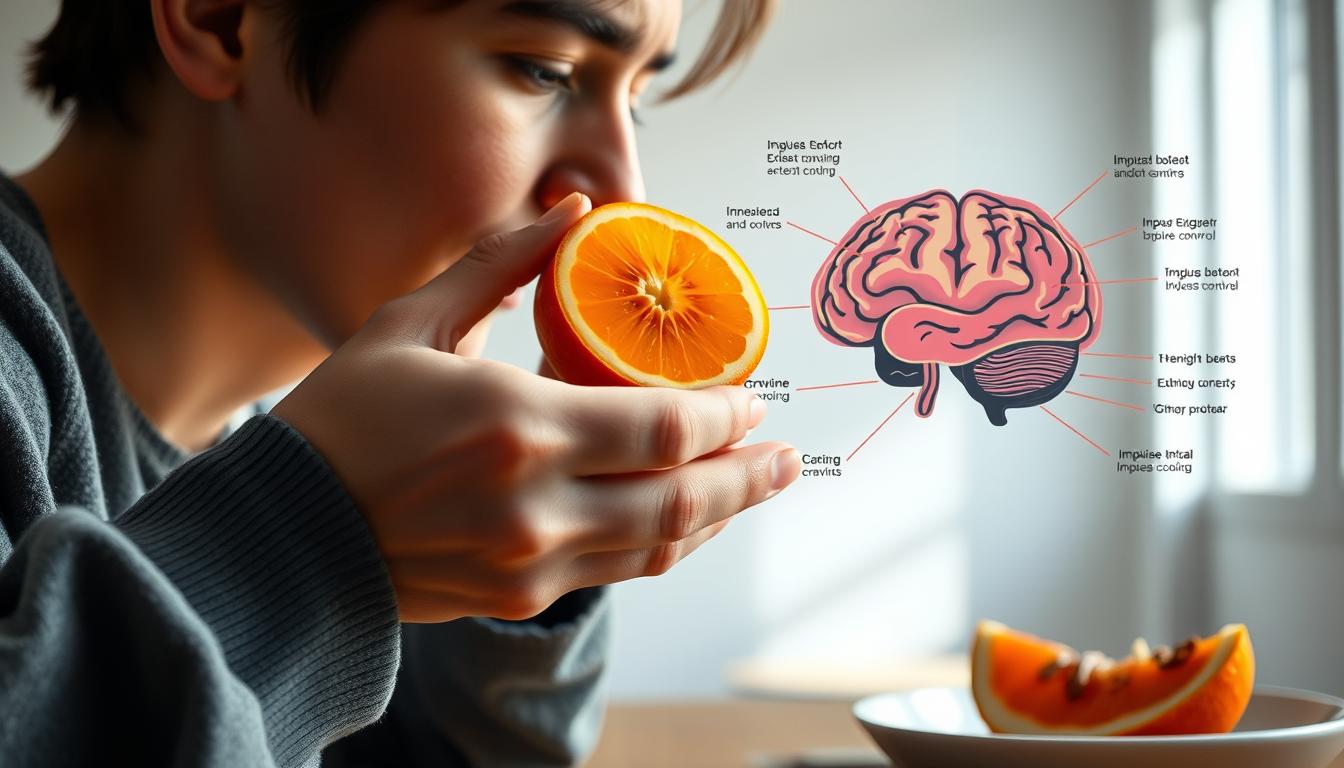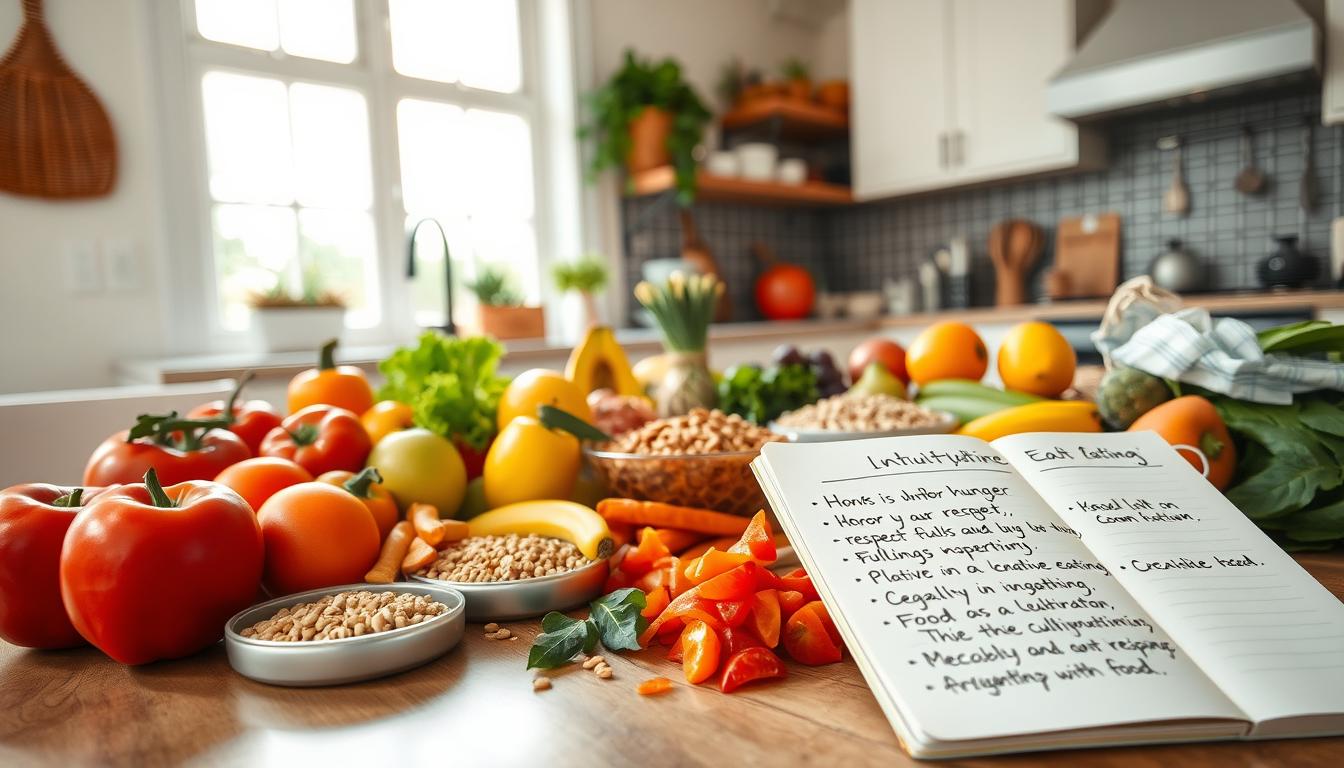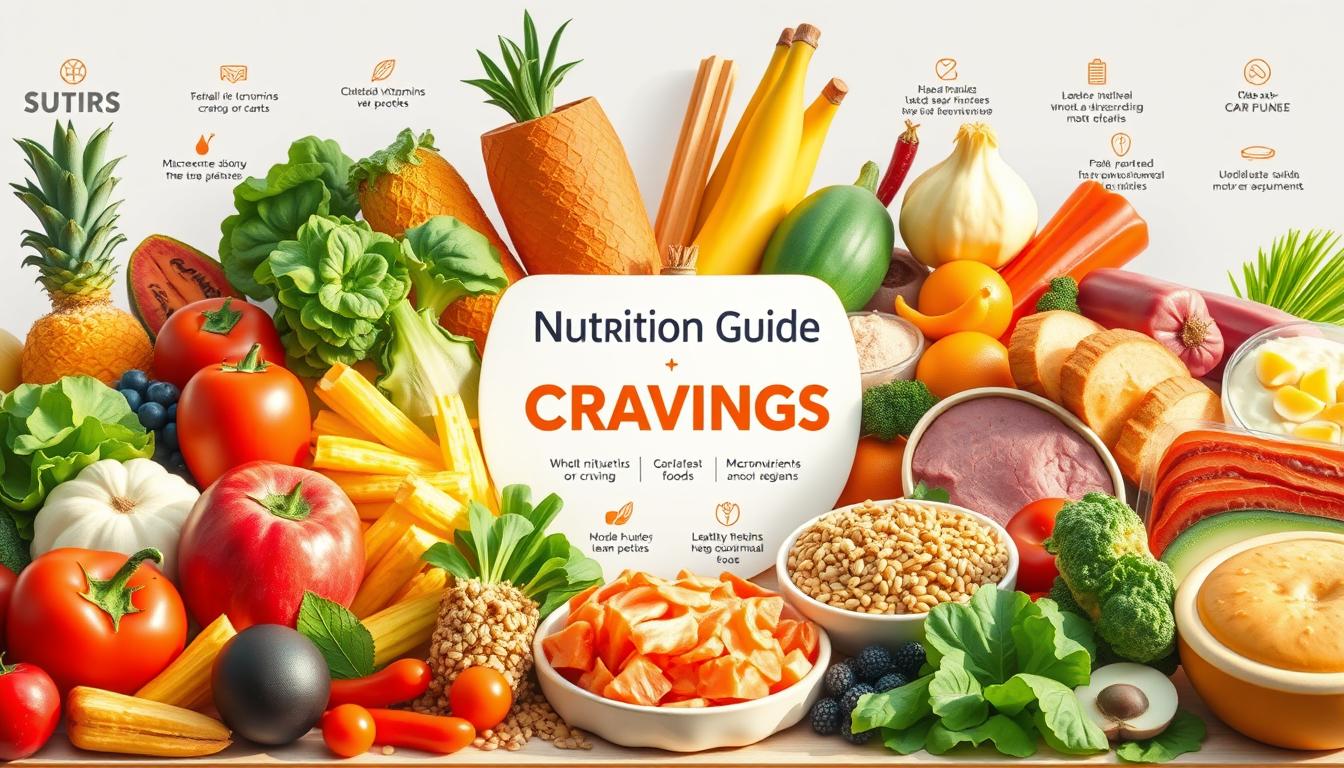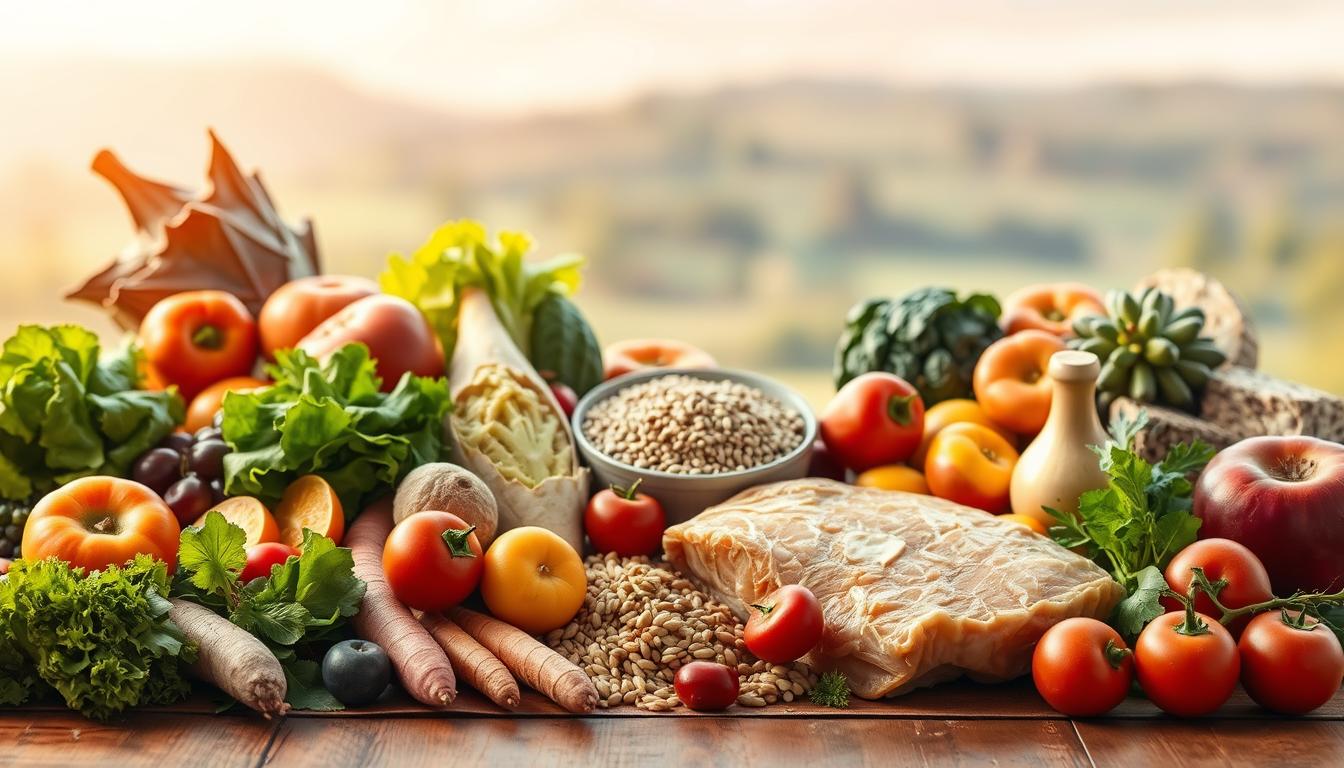Did you know 42% of adults gained an average of 29 pounds during the COVID-19 pandemic? This is according to a JAMA Network Open study. Stress-driven snacking and endless fridge raids became survival tactics for millions. But, there’s a better way to rebuild your relationship with food.
Traditional diets often fail because they focus on restriction, not empowerment. A 2020 American Psychological Association survey found 61% of adults reported undesired weight changes during lockdowns. This shows willpower alone isn’t enough. This is where mindfulness practices shine. Research in Appetite Journal shows they reduce emotional eating by 40% when paired with practical food strategies.
This guide moves beyond quick fixes to explore a holistic approach that works in messy, unpredictable scenarios. You’ll learn how to decode hunger signals during work deadlines, social gatherings, and late-night cravings. You won’t have to feel guilty or obsessed.
Key Takeaways
- Pandemic-era eating habits created lasting challenges for 3 in 5 Americans
- Mindfulness techniques directly impact food decision-making brain regions
- Combining nutrition science with behavioral psychology yields lasting results
- Practical strategies work for office snacks, family dinners, and travel
- Sustainable changes beat short-term deprivation every time
Understanding the Science of Cravings
Your midnight snack runs or sudden dessert urges aren’t random. They’re complex biological and psychological reactions. Modern research shows cravings are a dance between brain chemistry and environment. This shapes our “food-seeking GPS.”

Biological Drivers Behind Food Urges
Blood Sugar Fluctuations and Hunger Hormones
When your blood sugar drops, ghrelin – the hunger hormone – surges by up to 30%. This biological alarm system evolved to prevent starvation. But now, it misfires in our snack-filled world. With leptin resistance, you’re set for cravings.
Dopamine’s Role in Reward-Seeking Behavior
Brain scans show sugary foods trigger dopamine releases like addictive substances. This “feel-good” chemical creates strong memory associations. Your brain remembers where to find your favorite candy bar.
Psychological Triggers to Recognize
Emotional Eating Patterns
Stress activates the same neural pathways that crave comfort foods. Chronic anxiety can make you seek fatty foods as emotional bandaids. Studies show 68% of emotional eating cases have this pattern.
Environmental Food Cues
We live in an “obesogenic environment” – where food marketing and availability create triggers. That coffee shop pastry display isn’t just décor. It’s a craving activator.
| Trigger Type | Key Mechanism | Management Strategy |
|---|---|---|
| Biological | Hormone fluctuations | Balanced protein intake |
| Psychological | Environmental cues | Mindful eating practices |
| Combined | Stress responses | 5-5-5 grounding technique |
Understanding these dual drivers helps you know when you’re hungry or craving. Next time cravings strike, ask: “Is this my body needing fuel or my brain seeking dopamine?” The answer might surprise you.
What Does “Eat With Intention” Really Mean?

Eating with intention means making food choices with thought. It’s different from strict diets that only focus on what you can’t eat. This way, you learn to enjoy food in a flexible and mindful way.
Moving Beyond Diet Mentality
Diet culture often labels foods as “good” or “bad,” leading to guilt and overeating. Intentional eating uses the RAIN technique to change this:
- Recognize cravings without judgment
- Allow the sensation to exist
- Investigate physical vs emotional triggers
- Nourish your body appropriately
“Food is neither medicine nor poison – it’s information your body uses to function.”
Key Components of Intentional Eating
Mindful awareness
Use the SAVOR principles to enjoy your meals:
- Slow down while chewing
- Notice the flavors and textures
- Check if you’re really hungry
- See how food makes you feel
- Focus on your meal without distractions
Nutritional needs assessment
Here’s a simple way to balance your meals:
| Homeostatic Needs | Reward-Based Cravings | Balanced Approach |
|---|---|---|
| Protein & fiber | Sweet/salty foods | 80% nutrient-dense + 20% enjoyable |
| Hydration | Crunchy textures | Infuse water with fruits/herbs |
| Regular meals | Emotional snacks | Scheduled “treat” windows |
This approach helps you tell the difference between real hunger and cravings. It leads to lasting habits that keep you healthy and happy.
Essential Tools for Craving Management
Managing cravings needs practical strategies that work in real life. These tools help you stay in control without feeling trapped. They mix mindfulness with nutrition for lasting results.
The 5-5-5 Grounding Technique
When cravings hit, pause and use your senses with this simple method:
- Name 5 objects you see around you
- Feel 4 physical sensations you’re experiencing
- Listen for 3 distinct sounds around you

This 60-second reset breaks the urge-to-eat cycle. Studies show it cuts impulsive eating by 38% with regular use.
Strategic Meal Planning Basics
Good nutrition planning is your first line of defense against cravings. Start with these basics:
Macronutrient Balancing
| Macronutrient | Role in Craving Control | Daily Goal |
|---|---|---|
| Protein | Stabilizes blood sugar for 4+ hours | 20-30% of calories |
| Healthy Fats | Promotes satiety signals | 25-35% of calories |
| Complex Carbs | Provides sustained energy | 40-50% of calories |
Smart Snack Preparation
- Pre-portion nuts/seeds into 100-calorie packs
- Keep cut vegetables with hummus in clear containers
- Freeze Greek yogurt bites for sweet cravings
Studies show prepping snacks in advance leads to better choices 73% of the time. Store ready-to-eat options at eye level in your fridge and pantry.
Social Situations and Peer Pressure
Social gatherings have changed a lot with COVID-19. Now, 63% of Americans are more aware of healthy choices in groups. This includes office parties and family dinners. We need to plan our eating to stick to our wellness tips without losing fun.

Navigating Office Parties
Pre-event nutrition strategies
Eat a snack rich in protein 90 minutes before the party. Try Greek yogurt with berries or hard-boiled eggs. They help keep your blood sugar steady, so you won’t overeat at the buffet.
Use Source 3’s plate strategy: start with vegetables, then add other foods.
Alcohol consumption guidelines
Drink water between cocktails to stay hydrated. Aim for no more than two drinks. Say “I’m pacing myself tonight” to politely decline more.
Choose wine spritzers over sweet cocktails to cut calories.
Family Gathering Survival Tactics
Polite refusal techniques
Use decentering from Source 1 to say no to pie. Say, “I appreciate it, but I’m listening to my body right now.” Offer to take leftovers home to show respect and keep your diet on track.
Healthy contribution ideas
Bring dishes like cauliflower mash or grilled vegetable skewers. Colorful presentation makes wellness tips more appealing. Research shows bright plates make diet choices seem less restrictive by 41%.
Remember, it’s okay to make mistakes at social gatherings. Aim for three healthy choices per event. This could be controlling portions, drinking mindfully, or choosing healthier recipes. These small steps can lead to lasting changes.
Late-Night Snacking Solutions
Controlling evening cravings is more than just willpower. It’s about listening to your body’s natural rhythms. Studies show that late-night hunger often comes from hormonal changes, not real hunger. Let’s look at ways to break this cycle and keep a balanced diet.

Understanding Circadian Hunger Cues
Your ghrelin levels (the hunger hormone) go up between 8 PM and midnight. Research shows that eating less protein or fiber during the day makes these peaks worse. To fight this:
- Finish dinner 3 hours before bedtime
- Include 20-30g of protein in your last meal
- Drink 12 oz of water before cravings hit
Bedtime Routine Adjustments
Turn snack time into a holistic approach to unwinding. Studies show that calm evening routines can cut cravings by 43%.
Herbal Tea Rituals
Choose these teas over sugary snacks:
- Chamomile (reduces cortisol)
- Peppermint (curbs appetite)
- Valerian root (promotes sleep)
Sleep Hygiene Practices
Make your environment less tempting for snacks:
- Dim lights 90 minutes before bed
- Practice Source 3’s 4-7-8 breathing technique
- Use blackout curtains to regulate melatonin
These changes help your eating match your natural energy cycles. By focusing on when you eat and managing stress, you’ll create lasting habits. These habits will support your balanced diet without sacrificing sleep.
Emotional Eating Intervention Strategies
When stress or boredom hits, 38% of adults turn to snacks. This cycle can be broken with tools that tackle both immediate and long-term issues. These strategies help you grow stronger without feeling deprived.

Developing an Emotional First Aid Kit
Make a personal toolkit to stop cravings early. Studies show having non-food options can cut down impulsive eating by 42%.
Non-food comfort items
- Textured stress balls for tactile stimulation
- Essential oil rollers with calming scents
- Curated playlists for mood shifts
Quick stress relief exercises
- 90-second box breathing: Inhale 4 counts, hold 4, exhale 6
- Progressive muscle relaxation sequences
- Five-senses grounding technique (identify colors/textures/sounds)
Journaling for Pattern Recognition
EMA (Ecological Momentary Assessment) tracking shows how moods and food choices are linked. Logging regularly can reveal your personal triggers in 2-3 weeks.
Mood-food tracking methods
- Use color-coded icons for emotions (red = anger, blue = sadness)
- Note physical hunger cues before eating
- Track environmental factors like sleep quality
Progress assessment techniques
- Weekly review of craving frequency/duration
- Monthly comparison of emotional vs physical hunger episodes
- Celebrate non-scale victories like improved stress responses
“Journaling creates a pause between impulse and action – the critical window for making conscious choices.”
Use these wellness tips regularly to change your automatic responses. Remember, making progress is more important than being perfect when learning to manage your emotions.
Nutritional Deficiencies and Cravings
Your midnight chocolate cravings might be more than just a sweet tooth. They could signal a magnesium deficiency. The body often uses food urges as coded messages about nutrient needs. By learning to decode these signals, you gain power to make healthy choices that satisfy both cravings and biological requirements.

Common Nutrient-Related Food Urges
Intense chocolate cravings frequently point to low magnesium levels. This essential mineral regulates over 300 bodily processes, including stress response and muscle function. Dark leafy greens and pumpkin seeds offer plant-based solutions, but many people often don’t get enough.
Magnesium and Chocolate Cravings
When cravings strike, reach for 70% dark chocolate instead of milk chocolate. A single ounce provides 15% of your daily magnesium while delivering antioxidants. Pair it with magnesium-rich almonds for a doubly effective snack.
Protein Needs and Savory Desires
Constant thoughts of burgers or jerky might indicate protein deficiency. “Protein cravings often emerge when blood sugar levels fluctuate,” explains nutritional therapist Dr. Lisa Carter. Lentils and quinoa provide complete plant-based proteins that stabilize energy without saturated fats.
Smart Supplementation Approaches
Before grabbing supplements, consider these evidence-based strategies. Professional testing eliminates guesswork, while whole foods offer balanced nutrient packages that pills can’t replicate.
Professional Testing Options
- Micronutrient panels assess vitamin/mineral levels
- Hair analysis detects long-term deficiencies
- Genetic testing reveals absorption challenges
Whole Food Alternatives
| Nutrient | Supplement | Whole Food Source |
|---|---|---|
| Magnesium | Citrate capsules | Spinach, cashews, black beans |
| Protein | Whey powder | Lentils, Greek yogurt, tempeh |
| Iron | Ferrous sulfate | Oysters, fortified cereals, tofu |
For sustainable results, combine your nutrition guide knowledge with mindful eating practices. Track cravings in a food journal to spot patterns, then experiment with targeted whole food swaps. This approach addresses root causes while building lifelong healthy choices habits.
Grocery Store Navigation Tactics
Learning how to navigate supermarkets can make shopping more intentional. With 68% of impulse buys due to clever placement of products (Source 1), your nutrition guide begins at the entrance.

Perimeter Shopping Strategy
Fresh foods like fruits, proteins, and dairy are placed on the edges for a reason. They are less likely to trigger overeating due to their natural appeal. Here’s a simple 3-step plan:
- Begin with produce for healthy snacks
- Then, visit the protein sections
- Save grains for last to avoid extra purchases
Decoding Food Marketing Tricks
Food companies spend $14 billion a year to make processed foods irresistible. Here are some tips to help you.
Understanding Label Claims
“Sugar-free” often means artificial sweeteners, and “multigrain” might be refined flour. Always check:
- Ingredients order (first 3 = main components)
- Added sugars under multiple names
- Servings per container calculations
Portion Size Reality Checks
Compare packaging claims to actual sizes with this guide:
| Product | Label Serving | Common Portion | Calorie Difference |
|---|---|---|---|
| Potato Chips | 1 oz (15 chips) | 3 oz (45 chips) | +320 calories |
| Granola | ¼ cup | ¾ cup | +280 calories |
| Pasta | 2 oz dry | 4 oz dry | +200 calories |
Stay mindful by measuring tricky items at home. This helps you avoid overeating in the future.
Restaurant Survival Guide
Eating out doesn’t have to ruin your healthy choices. With smart planning and habits, you can enjoy meals out while keeping a balanced diet. Here are some tips to help you navigate menus, manage portions, and stay in control.

Menu Decoding Techniques
Scan menus like a food detective. Look for keywords like grilled, steamed, or roasted. These signal healthier options. Avoid dishes with crispy, breaded, or smothered labels, as they often have more calories.
Healthy Preparation Requests
Don’t be shy to customize your order. Ask for:
- Vegetables instead of fries
- Lean protein swaps (like chicken breast for sausage)
- Oil-free cooking methods
Sauce and Dressing Management
Condiments can quickly add calories. Ask for sauces on the side and use the dip-and-drizzle method. Choose vinegar-based dressings over creamy ones.
Portion Control Methods
Restaurant servings are often too big. Here are ways to avoid overeating:
Box-and-Save Immediately Tactic
Split your meal before eating. Put half in a to-go container. This helps you eat less and saves leftovers for tomorrow.
Sharing Strategies
Make dining out a team effort. Share an entrée with a friend or order several appetizers. You get to try more without eating too much.
“Mindful ordering starts before you even see the menu. Take three deep breaths to ground yourself—it helps you make intentional decisions.”
Use these strategies with mindful eating. Chew slowly, enjoy the flavors, and check your hunger halfway through. Restaurants can be part of your wellness journey, not a hindrance.
Travel and Vacation Planning
Keeping up with wellness goals while traveling needs a holistic approach. This means being prepared yet flexible. Whether you’re in a rush or relaxing, smart strategies help you stay focused. Studies show 73% of travelers rely on mobile apps for healthy food choices.

Airport Food Court Navigation
Airports can be tough with all the fast food. Look for protein-rich salads or grilled wraps. Use your phone to check nutrition info before buying. If you’re tempted, try the “5-5-5” method: breathe for five, check if you’re hungry, then decide.
Essential Travel Kitchen Tools
- Collapsible silicone bowl for portion-controlled meals
- Mini immersion blender for smoothies
- Reusable cutlery set with a bottle opener
- Portable electric kettle for oatmeal or soups
Hotel Room Meal Prep Basics
Turn your hotel room into a kitchen. Use the ice bucket for perishables if there’s no fridge. Mix shelf-stable items like quinoa with canned tuna for fast meals. Studies show prepping two meals a day can reduce stress eating by 41%.
Non-Perishable Snack Ideas
- Single-serve almond butter packets with apple chips
- Seaweed snacks rich in magnesium
- Dark chocolate-covered espresso beans (limit to 10 pieces)
- Turmeric-spiced roasted chickpeas
“Packing nutrient-dense snacks cuts impulsive purchases by 65% during travel delays.”
Use these wellness tips with apps that track water intake. A holistic approach isn’t about being perfect. It’s about setting up systems that work anywhere.
Workplace Challenges Solutions
Dealing with office food needs smart planning. It’s about making healthy choices and avoiding emotional eating. Studies reveal workers face 15% more snack temptations than at home. So, finding effective solutions is key to success.

Desk Drawer Nutrition Makeover
Change your desk snacks with smart habits. Fill your drawer with three types for energy balance:
- Protein anchors: Almond packs, roasted chickpeas
- Fiber boosters: Dried fruit, whole grain crackers
- Crunch craving solutions: Veggie chips, roasted seaweed
Use post-it notes to remind you to drink water. This helps fight false hunger. Also, switch snacks every week to keep things interesting.
Meeting Treat Temptations
Strategic Seating Arrangements
Choose seats away from snacks or desserts. Sit near water stations to encourage getting up and moving.
Verbal Deflection Scripts
Learn to say no nicely without hurting feelings:
“That looks amazing, but I’m saving room for lunch!”
“I’d love the recipe instead – my weekend baking project needs inspiration.”
Also, do quick mindfulness exercises. Take three deep breaths before grabbing snacks.
Seasonal Food Challenges
It’s possible to enjoy festive times and keep your nutrition goals in mind. Rich meals are common at gatherings, but you don’t have to give up your balanced diet. With some careful planning, you can enjoy traditions and stay healthy.

Holiday Season Preparation
Begin by practicing decentering. This means watching your cravings without letting them control you. At buffets, take a moment to think about what you want:
- Start with half your plate full of roasted veggies or salads
- Pick one special treat you really want
- Offer to bring a dish like herb-roasted turkey breast
Studies show that bringing healthy dishes can cut down on overeating by 23%. Instead of eating more, focus on talking and enjoying the company.
Summer BBQ Strategies
Grill-outs can be tough with all the tempting sides and desserts. Here are some wellness tips to help you stay on track:
Grill Master Negotiations
Ask politely for:
- Chicken or fish instead of sausages
- Veggie skewers with your meat
- Smaller burger patties to control portions
Potluck Participation Rules
At cookouts, remember to:
- Bring a colorful salad or fruit platter
- Use a 9-inch plate instead of the usual 12-inch ones
- Try high-calorie foods in small amounts
This way, you can enjoy the flavors without ruining your balanced diet. Celebrations are about making memories, not just eating.
Technology-Assisted Craving Control
Your smartphone and wearable devices now offer powerful tools to support intuitive eating practices. Research shows app-based interventions improve craving management by 37% through real-time feedback (Source 2). These technologies help bridge the gap between biological signals and conscious food choices.

Best Nutrition Tracking Apps
Modern nutrition guide apps do more than count calories. Apps like MyFitnessPal and Lose It! combine essential features with behavioral science principles.
Barcode Scanner Features
Instant food logging through camera scanning:
- Identifies 90%+ packaged foods in US markets
- Auto-calculates macronutrient ratios
- Flags common craving triggers like added sugars
Mindful Eating Timers
Built-in reminders encourage conscious consumption:
- 20-minute meal duration alerts
- Bite pace vibration cues
- Pre-meal breathing exercises (Source 3)
Wearable Device Integration
Smartwatches now detect physiological craving precursors. A 2023 study found devices predicting food urges 15 minutes before conscious awareness (Source 1).
Stress Level Monitoring
Advanced sensors track:
- Heart rate variability patterns
- Electrodermal activity spikes
- Body temperature fluctuations
Hydration Tracking
Automated water intake features:
- Skin hydration sensors
- Smart bottle connectivity
- Thirst-craving differentiation alerts
Combining these tools creates a complete nutrition guide ecosystem. EMA tracking data (Source 2) proves users maintain intuitive eating habits 2.3x longer with tech support than through willpower alone.
Building Sustainable Habits
Creating lasting change needs more than just willpower. It requires a holistic approach that connects daily actions with long-term wellness goals. Research shows habits make up 40% of our daily behaviors. This makes them key to healthy living.
Let’s look at science-backed ways to turn short-term efforts into lasting habits.
The 21-90 Rule Implementation
Neuroscience shows habit formation goes through three phases, similar to learning meditation:
- Days 1-21 (Conscious Effort): Focus on consistent trigger-action patterns, like drinking lemon water before breakfast
- Days 22-90 (Automaticity): Behaviors become ingrained through basal ganglia processing
- Day 91+ (Lifestyle Integration): Actions feel natural, similar to established gratitude practices
Use simple tools to track progress:
“A habit tracker isn’t about perfection – it’s about patterns”
Accountability Systems That Work
Effective wellness tips highlight the importance of external support. Here are some evidence-based options:
Buddy System Setup
- Choose partners with complementary strengths (early riser + night owl)
- Schedule bi-weekly video check-ins
- Create shared milestone rewards (non-food related)
Professional Coaching Options
- Certified nutritionists for personalized meal strategies
- Behavioral therapists for emotional eating patterns
- Fitness trainers for home workout plans
| Features | Buddy System | Professional Coaching |
|---|---|---|
| Cost | Free | $50-$200/session |
| Customization | Moderate | High |
| Expertise Level | Peer-based | Certified specialists |
Using both buddy systems and professional coaching can have the greatest impact. 68% of successful habit adopters use a mix of support. Remember, lasting change is about strategic wellness tips that fit your lifestyle.
Conclusion
Real craving control starts with recognizing patterns. Studies show mindfulness can cut down food urges by 40%. It helps us tell apart emotional needs from physical ones.
Smartphone apps can help track your progress. But, what works for someone else might not work for you. Your schedule and family needs are unique.
Mindful eating is all about trying new things. Try shopping on the store’s edges and use apps to alert you when you’re stressed. See if writing in a journal or using the 5-5-5 technique helps you.
Studies say it’s important to find what works for you. This is why nutritional plans are made just for you.
Focus on building good habits, not just cutting out bad ones. Doing things the same way for 21-90 days makes them automatic. Celebrate small victories, like better grocery shopping or menu reading skills.
Managing cravings isn’t about being perfect. It’s about being strong enough to handle life’s temptations. Every choice you make helps you grow.
Your journey changes how you make decisions, not just what you eat. Start with a positive mindset for tomorrow’s breakfast. See how your food choices can lead to personal growth.